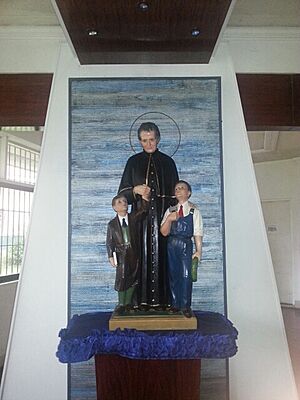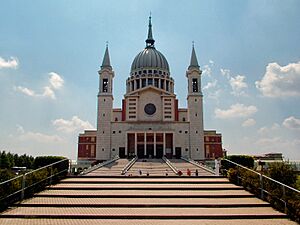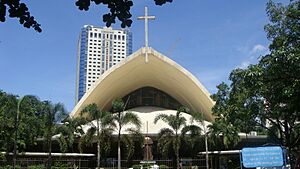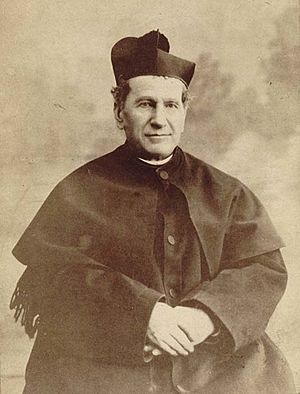John Bosco facts for kids
Quick facts for kids SaintJohn Bosco SDB |
|
|---|---|

Bosco in 1880
|
|
| Priest and confessor "Father and Teacher of Youth" |
|
| Born | 16 August 1815 Castelnuovo d'Asti, Piedmont, Sardinia-Piedmont |
| Died | 31 January 1888 (aged 72) Turin, Kingdom of Italy |
| Venerated in | Catholic Church Anglican Communion |
| Beatified | 2 June 1929, Rome by Pius XI |
| Canonized | 1 April 1934, Rome by Pius XI |
| Major shrine | Basilica of Our Lady Help of Christians, Turin, Italy |
| Feast | 31 January |
| Attributes | Cassock, Biretta |
| Patronage | |
John Melchior Bosco, often called Don Bosco, was an Italian Catholic priest and teacher from the 1800s. He is now known as a saint. He lived in Turin, a city where many people faced problems because of new factories and city growth. Don Bosco spent his life helping and teaching street children, young people who had gotten into trouble, and other kids who needed help.
He created a special way of teaching called the Salesian Preventive System. This method focused on love and kindness instead of punishment. Don Bosco was a big follower of Francis de Sales and deeply respected the Virgin Mary. He later named his main group, the Salesians of Don Bosco, after Francis de Sales.
With Maria Domenica Mazzarello, he also started a group for girls called the Institute of the Daughters of Mary Help of Christians. These nuns, known as the Salesian Sisters, helped and educated poor girls. Don Bosco also taught Dominic Savio, a young boy he wrote about, which helped Dominic become a saint too. Don Bosco also helped create groups where young Catholic workers could support each other. For example, he made rules in 1850 to help apprentices if they lost their jobs or got sick.
In 1869, Don Bosco started the Association of Mary Help of Christians (ADMA). This group helped ordinary people connect with the Salesian mission. Its goal was to encourage respect for the Holy Sacrament and Mary Help of Christians.
In 1875, Don Bosco began publishing the Salesian Bulletin. This magazine is still published today in many languages. A year later, he started the Association of Salesian Cooperators. This group of everyday people shared his goal of educating the poor. Don Bosco built a large network of groups and centers to continue his work. After being recognized as "blessed" in 1929, Pope Pius XI declared him a Catholic saint in 1934.
Contents
Life of Don Bosco
Early Years
John Bosco was born on August 16, 1815, in a small village called Becchi, Italy. This area is now known as Castelnuovo Don Bosco, named after him. He was the youngest of three sons. His father died when John was just two years old, leaving his mother, Margherita Occhiena, to raise the boys alone. She was a very important person in John's life and supported his dreams.
When John was nine, he had a dream that changed his life. In this dream, he saw many poor boys using bad language. A noble man appeared and told him, "You will win these friends not with hitting, but with gentleness and kindness." This dream stayed with him forever.
As a child, John loved watching traveling performers. He learned juggling and acrobatics. He would then put on his own shows for other kids, always starting and ending with prayers. He used money from selling birds he hunted to buy what he needed for his shows.
Because his family was poor, John couldn't go to school much at first. He worked as a shepherd. A kind priest, Don Calosso, noticed John's amazing memory and helped him learn. John's childhood experiences made him want to become a priest. This was unusual for a farm boy back then.
At age 12, John left home because of arguments with his older brother, Antonio. He found work as a farmhand. Living on his own at such a young age helped him understand and feel for other abandoned boys. Later, in 1830, he met Joseph Cafasso, a young priest who helped him get proper schooling. John's mother worked hard to pay for his education. In 1835, he entered the seminary in Chieri. Six years later, in 1841, he became a priest at age 26.
Becoming a Priest
After becoming a priest, Don Bosco moved to Turin. This city was growing fast, and many poor families lived in crowded areas. Don Bosco worked with Father Cafasso, visiting prisons. He saw many young people who kept getting into trouble after leaving prison. This made him want to help orphaned and abandoned boys. He taught them about faith and helped them find jobs.
Don Bosco realized that traditional church methods weren't enough for the many new people in the city. He decided to meet boys where they were, like in shops and marketplaces. He called his work the "Oratory." It wasn't just a charity; it became his main focus. He helped boys find work and even tried to give them places to sleep.
At first, he had trouble finding a stable place for his Oratory. Neighbors complained about the noise from the boys playing. There were even rumors that his meetings could lead to a revolution. But Don Bosco didn't give up. In 1847, he and his mother started taking in orphans in their rented rooms. The number of boys he helped grew from 36 in 1852 to 800 later on.
Helping Young People
Don Bosco also worked to protect young apprentices. He created some of the first apprenticeship contracts in Turin. These contracts made sure employers treated the boys fairly. He insisted that boys only work in their agreed trade and that corrections should be verbal, not physical. He also made sure they had rest days and annual holidays. Even with these efforts, life for apprentices was still hard.
Don Bosco had important friends, like Urbano Rattazzi, a justice minister. Even though Rattazzi had different political views, he saw the value in Don Bosco's work. Rattazzi even advised Don Bosco on how to keep his work going, suggesting he form a religious order. Don Bosco was already thinking about this and slowly organized his helpers into a group. The Pope at the time, Pope Pius IX, also supported the idea of a new religious order.
Don Bosco did not like the ideas that came from the French Revolution, which tried to remove religion from public life. He believed the Pope had the highest authority. Some people opposed Don Bosco's work. Some clergy thought he was taking people away from their churches. Some politicians worried his large group of young men could cause trouble. The police chief in Turin also watched him closely. Despite several attempts on his life, Don Bosco continued his work, possibly protected by orders from the king.
Starting the Salesians



Some of the boys Don Bosco helped wanted to follow in his footsteps and serve abandoned youth. This was the beginning of the Salesian Congregation. In 1857, Don Bosco wrote rules for his helpers. These rules were officially approved by Pope Pius IX in 1873, creating the Society of Saint Francis de Sales.
In 1859, Don Bosco chose 15 young men and one high school boy to form the core of the Salesians. This group would continue his work. The Salesian Congregation included priests, those studying to be priests, and lay brothers (who were not priests).
Don Bosco then worked with Mary Mazzarello to create a similar group for girls. In 1871, they founded the Daughters of Mary Help of Christians. In 1874, he started another group, the Association of Salesian Cooperators. These were mostly everyday people who worked for young people but were not part of a religious order. The first Salesians traveled to Argentina in 1875 to start missions there.
Don Bosco had always wanted to be a missionary. He believed that the people of Patagonia in Argentina were the ones he had seen in a dream. In late 1874, he received requests from Argentina to start a parish and a school. Don Bosco saw this as a sign from God. He began preparing a mission, planning to set up safe bases for his missionaries. Many volunteers came forward, and the first missionaries left in October 1875.
Don Bosco's Teaching Style
Don Bosco developed a special way of teaching and guiding young people. He believed it was better than the strict, punishment-based methods common at the time. He called his approach the "Preventive System."
In 1877, Don Bosco wrote an essay called The Preventive System in the Education of the Youth. In this essay, he explained his system. It was based on three main ideas: reason, religion, and loving kindness. The goal was to help young people become "good Christians and honest citizens." While the idea of a preventive system wasn't entirely new, Don Bosco was one of the first to put these ideas into practice on a large scale.
His Writings and Legacy
Don Bosco wrote many books and articles, though they were mostly known within his own religious order and by readers of his Salesian Bulletin. He was a skilled historian. In 1881, he wrote A Compendium of Italian History from the Fall of the Roman Empire. He was also a great biographer, writing about his mentor, Joseph Cafasso, and his student, Dominic Savio. These biographies were important in helping Dominic Savio become a saint.
Don Bosco's writings and publications include over 220 titles. He even had his own printing workshop where boys learned printing skills for future jobs.
Death and Sainthood
Saint Don Bosco passed away on January 31, 1888. Thousands of people attended his funeral. The Catholic Church in Turin began to investigate his life to see if he should be declared a saint. The Salesians, the Daughters of Mary Help of Christians, and the Salesian Cooperators all gave strong testimonies about his good works.
Pope Pius XI, who had known Don Bosco, strongly supported his cause. Pope Pius XI declared Don Bosco "blessed" on June 2, 1929. Then, on Easter Sunday, April 1, 1934, he made Don Bosco a saint. He was given the special title "Father and Teacher of Youth." Later, in 1949, Pope Pius XII named him the patron saint of Catholic publishers.
Don Bosco is also known as the patron saint of illusionists. In 2002, a magician named Silvio Mantelli asked Pope John Paul II to officially declare Don Bosco the patron of stage magicians. Catholic magicians who use magic to teach about faith often give free shows to children in need on Don Bosco's feast day. Don Bosco's work was continued by one of his first students and helpers, Michael Rua, who became the leader of the Salesian Society after Don Bosco's death. The Church of England also remembers Don Bosco on January 31.
Images for kids
-
St. John Bosco Parish Church, Makati, Philippines
-
Statue of Saint John Bosco, Ronda, Spain
-
Statue of Saint John Bosco, Makati, Philippines
-
Statue of Saint John Bosco at the Diocesan Shrine of Mary Help of Christians, Canlubang, Laguna, Philippines
See also
 In Spanish: Juan Bosco para niños
In Spanish: Juan Bosco para niños









